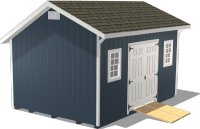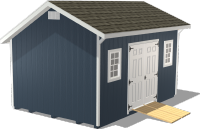How to Move a Shed? Relocation Made Simple
by Dakota Storage Buildings, on September 16, 2024

After you buy a storage shed, choosing the right spot for it is crucial for convenience and functionality. However, sometimes you have to relocate the shed for yard renovations, changes in use, or moving homes. Moving outdoor storage buildings can seem like a complicated task, but with careful planning and the right approach, it can be accomplished smoothly. Curious about the details of how to move a shed? Let’s explore the steps for selecting the perfect spot for your shed and tips for relocating it if needed.
Determining the Perfect Location for Your Shed
To find the ideal location for your shed, you must consider various factors to ensure it meets your needs and complies with local regulations. Proper placement enhances functionality, accessibility, and longevity, ensuring that your shed serves its intended purpose effectively.

Assesses Your Needs
First, identify the purpose of your shed. Is it for storage, a workshop, or another use? Consider how often you will need to access the shed and how convenient its location should be. For instance, if you use the shed for storing gardening tools, placing it near your garden makes sense. If it serves as a workshop, placing it close to your home makes it easier to access power and utilities.
Evaluate Your Yard Space
Measure the available space in your yard to ensure the shed will fit comfortably. Look for level ground to provide a stable foundation and avoid areas with uneven terrain. Check for drainage patterns and place the shed away from spots where water accumulates. This could lead to structural issues over time. Consider the natural light in the area, as some sheds will benefit from sunlight, while others might need shade to protect sensitive items.
Consider Legal and Safety Factors
Research local zoning laws and building codes to ensure your shed complies with regulations. This may include setback requirements, height restrictions, and permits. Additionally, check for underground utilities and overhead obstructions that could interfere with the placement. Before finalizing the location, consult with local authorities to confirm that the placement is compliant so you avoid potential legal issues. You may want to consider safety considerations as well. This could include ensuring outdoor storage buildings are not placed under large trees that could drop branches or in areas prone to flooding.
Tips for Finding the Perfect Shed Spot
Choosing the best spot for your shed requires balancing accessibility, aesthetics, and future needs. Thoughtful planning ensures that your shed serves its purpose efficiently while enhancing the overall appearance and functionality of your backyard.

Ensure Easy Shed Access
Ensure the shed is easily accessible for day-to-day use. Consider how often you will need to access the shed and the type of access that will be required. For instance, a garden shed should be close to your garden, while a workshop might benefit from being nearer to your driveway or garage. Make sure there is a clear, direct path to the shed, free from obstacles that could hinder movement, especially if you will be transporting heavy equipment or materials.
Integrate Your Shed With Yard Design
Use landscaping to seamlessly integrate the shed into your yard’s design. Consider planting shrubs or flowers around the shed to soften its appearance and make it a cohesive part of your outdoor space. Align the shed with other structures, like a fence or a trellis, to create a unified look. The color and style of the outdoor storage buildings should complement your house and garden aesthetics, enhancing the overall visual appeal of your property.
Plan for Future Expansion
You never know what the future holds, especially when it comes to storage needs. It is smart to leave extra space around the shed for potential future expansions or additions. Consider how changes in your yard might affect the shed’s location. For instance, if you plan to plant trees or expand your garden, make sure the shed will not obstruct these future developments. You will need to leave adequate space to move around the shed for maintenance or modifications. Think about how your family’s needs might evolve over time and choose a location that offers flexibility for future adjustments, ensuring the shed remains a valuable asset for years to come.
Anticipating and Preparing for Future Shed Moves
Even with careful planning, you might need to relocate your shed. Preparing for this possibility can save time and effort, ensuring that your shed can be moved with minimal disruption and damage.
Early Steps for Smooth Shed Relocation
If you may need to relocate your outdoor storage buildings in the future, it is essential to consider a few key factors to make the process smoother. Opt for a pre-built shed that is designed with modular components. This can make the disassembly and reassembly process smoother. Keep a detailed inventory of all components and parts, which will be valuable during the reassembly process. Labeling parts before disassembly can simplify the process and avoid confusion when reassembling your shed in its new location. This preparation ensures that the shed can be moved and reinstalled with minimal hassle.
Signs It's Time to Relocate Your Shed
There are multiple reasons why a shed may need to be moved. Yard renovations, expansions, or changes in how you want to use it may require relocation. Be aware of these signs to plan accordingly. For instance, if you are planning to install a new pool, patio, or garden area where the shed currently sits, you will need to find a new place for the shed. Converting the shed from a storage space to a workshop or vice versa might also require a different location to better suit the new function. Additionally, changes in your household, such as adding new family members or acquiring new outdoor equipment, could also impact how and where your shed should be situated.
How to Move a Shed in 3 Steps
When relocation becomes necessary, follow these three steps for a smooth process to ensure your shed remains functional and intact.

1. Breaking Down Your Shed for Moving
Are you asking yourself how to move a shed? You have to start by safely disassembling the shed, organizing, and labeling all parts for easier reassembly. This ensures no pieces are lost or damaged during the move. Carefully remove roofing, wall panels, and other structural components, keeping all fasteners and small parts in labeled containers. Take photos before and during the disassembly process to use as references during reassembly. These could be helpful in creating a step-by-step guide for the reassembly process.
2. Safely Transporting Your Shed
As you disassemble the shed, wrap the parts in protective materials to prevent scratches and dents during the moving process. Use sturdy straps and padding to keep larger components safe and secure during transit. If you need to know how to move a large shed specifically, hiring professional movers may be wise. However, smaller, less complex, sheds are easy to move yourself. Professionals have the necessary equipment and expertise to handle large, heavy structures, while a DIY move can be more cost-effective if you have the right tools and help.
3. Reinstalling Your Shed in Its New Location
Before the shed arrives at the new location, you must ensure there is a proper foundation by preparing the ground and verifying it is level and solid. You may need to create a concrete or gravel slab to ensure the shed remains stable. Reassemble the shed carefully, paying attention to maintaining its structural integrity. Follow the labeled parts and reference photos to put everything back together correctly. Ensure all connections are secure, and check for any potential weak spots or areas that may need reinforcement. Being meticulous throughout this process will help preserve the shed's durability and functionality in its new location.
Handling Shed Relocation With Professional Expertise
Sometimes, professional assistance is the best option for moving your shed. Experienced movers can handle the complexities of disassembly, transportation, and reassembly, ensuring the shed remains intact and functional.
Knowing When to Call in the Pros for Your Shed Move
If the outdoor storage buildings are large or complex, or if the move involves navigating difficult terrain, professional help might be necessary. If the space is tight, has steep inclines, or long distances, professional movers have the right equipment and expertise to handle the move. Additionally, if you lack the time or manpower to safely and efficiently move the shed, hiring professionals can save you from potential injuries and costly mistakes. Some movers can even relocate your shed without disassembling it, using specialized equipment like trailers and mules.

Picking the Best Shed Moving Service
Look for a shed moving service with experience and good reviews. Ask about their process, insurance, and guarantees to ensure they meet your needs. Verify their credentials and ask for references to get an idea of their track record. It is also important to confirm that they are equipped to handle your specific type of shed and any unique challenges your move might present. Ask if they offer additional services such as site preparation and foundation work, which can streamline the relocation process.
Understanding the Costs of Hiring Shed Movers
How much does it cost to move a shed? The cost of a professional relocation includes disassembly, transport, and reassembly. The total price will depend on the specific moving company you choose. Compare quotes from different providers to get the best value. Be aware of any additional fees for permits, insurance, or specialized equipment. It is essential to get a detailed, written estimate to avoid unexpected charges. While professional services can be more expensive upfront, they can ultimately save you money by preventing damage and ensuring the shed is moved efficiently and safely.
Ensure Easy Relocation With Proper Shed Planning
Choosing the right spot for your outdoor storage buildings initially can save you from knowing how to move a storage shed. However, if moving becomes necessary, proper planning and professional assistance can make the process painless. Consider using our 3D Configurator Tool to customize your own shed, ensuring it meets your needs and can be easily relocated if necessary. Proper planning and preparation are key to a successful shed relocation, ensuring your shed remains functional and aesthetically pleasing in its new location.

























